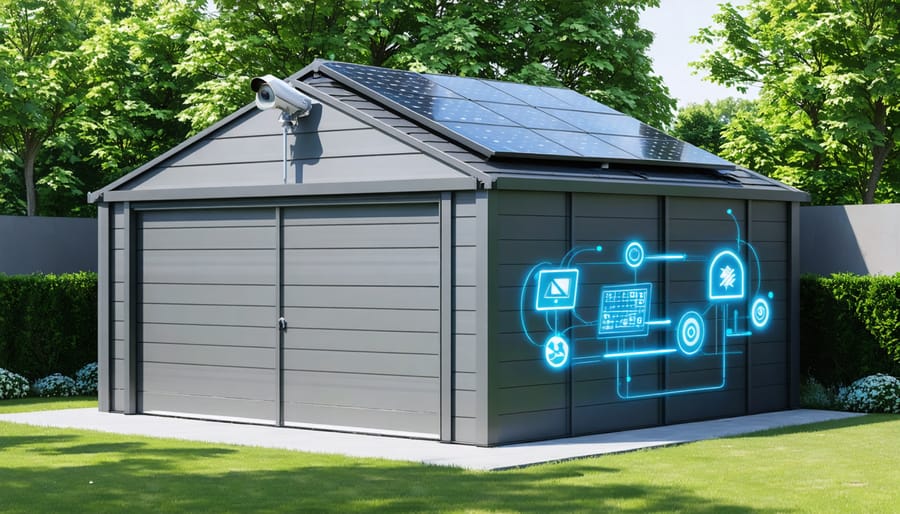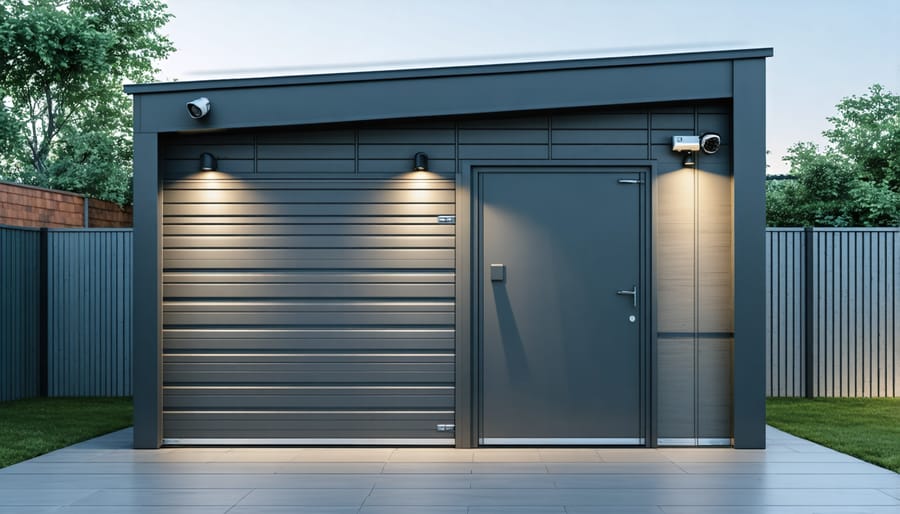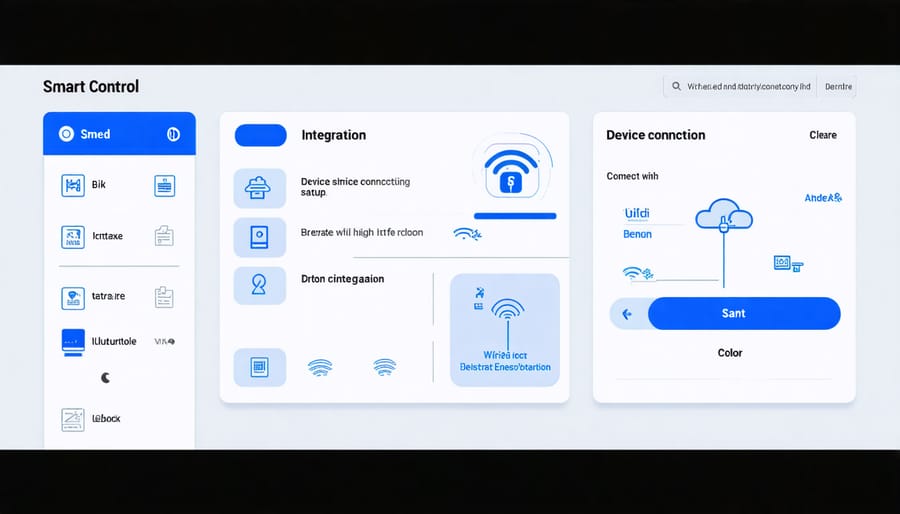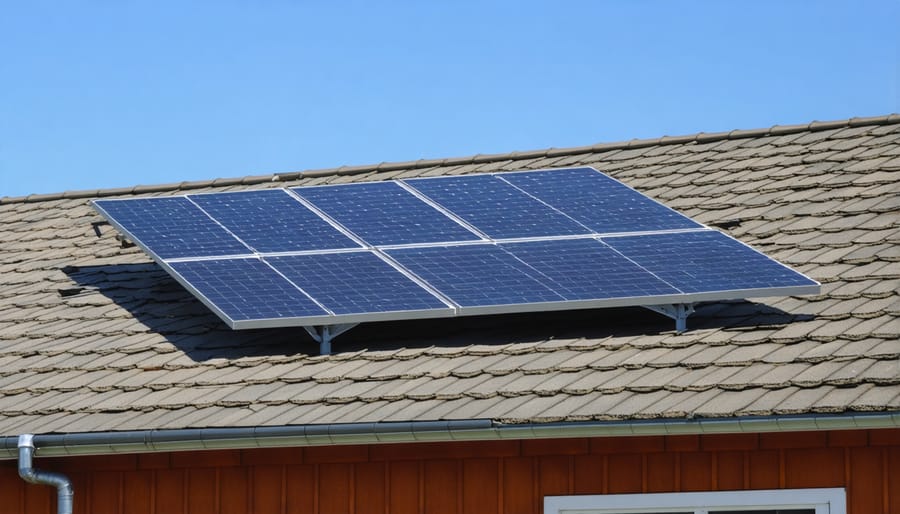Smart Shed Tech That Makes Your Home Life Easier

Transform your home into an energy-efficient powerhouse with smart electrical solutions that seamlessly connect every corner of your living space. Modern smart homes now integrate automated lighting, climate control, and energy monitoring systems that reduce utility bills by up to 30% while enhancing daily comfort. Voice-activated assistants orchestrate everything from morning routines to evening security checks, while smart meters provide real-time consumption data for optimal energy management. Imagine walking into rooms that automatically adjust temperature and lighting based on your preferences, or receiving instant alerts about unusual power usage patterns that could signal failing appliances. This isn’t just about convenience – it’s about creating an intelligent living environment that anticipates needs, maximizes efficiency, and provides unprecedented control over your home’s electrical systems through simple smartphone commands.
Smart Electrical Features Every Modern Shed Needs

Automated Lighting Systems
Modern smart interior lighting systems have revolutionized how we illuminate our homes. Motion sensors automatically activate lights when you enter a room and turn them off when you leave, saving energy and adding convenience to your daily routine. These intelligent sensors can be adjusted for sensitivity and timing, ensuring they work perfectly for your household’s needs.
Programmable LED lights offer incredible flexibility, allowing you to set different brightness levels and color temperatures throughout the day. Wake up to gentle, warm lighting in the morning, enjoy bright, productive light during work hours, and wind down with cozy, dim lighting in the evening. Many systems can be controlled through smartphone apps or voice commands, making it easy to adjust your lighting from anywhere.
Smart switches seamlessly integrate with your existing wiring while adding powerful features like scheduling, remote control, and energy monitoring. These switches can transform any traditional light fixture into a smart one, allowing you to create coordinated lighting scenes for different activities or times of day. Best of all, they’re designed to be user-friendly, making home automation accessible to everyone.
Climate Control Solutions
Modern climate control solutions are revolutionizing how we manage comfort in our smart electric homes. Smart thermostats lead the charge, learning your temperature preferences and daily routines to automatically adjust settings for optimal comfort and energy savings. These intuitive devices can be controlled remotely through smartphone apps, allowing you to warm up or cool down your home before you arrive.
Intelligent ventilation systems work in harmony with smart thermostats, monitoring air quality and automatically adjusting airflow when needed. Many homeowners report significant improvements in indoor air quality after installing these systems, which can filter out allergens and maintain fresh air circulation throughout the home.
Humidity control has become equally sophisticated, with smart sensors that can detect moisture levels and adjust accordingly. These systems help prevent mold growth while maintaining optimal comfort levels, especially important in bathrooms and basements. Some models even integrate with weather forecasts to anticipate and prepare for changes in outdoor conditions.
The real beauty of these climate control solutions lies in their seamless integration. When working together, they create a perfectly balanced indoor environment while potentially reducing energy costs by up to 20%.
Security Integration
Modern smart homes integrate seamlessly with comprehensive security systems to protect your family and property. Smart locks allow keyless entry through your smartphone, with temporary codes for guests or service providers. Connected doorbell cameras let you see and speak with visitors whether you’re home or away, while motion-activated security cameras monitor your property 24/7. These devices can work together through a central hub, sending instant alerts to your phone when unusual activity is detected. Smart alarm systems can automatically arm themselves when you leave and disarm when you return home. For added peace of mind, many security components can be voice-controlled through popular virtual assistants and integrate with smart lighting to create the appearance of occupancy when you’re away.
Setting Up Your Smart Shed System
Power Planning and Installation
Before diving into smart home features, it’s crucial to establish proper electrical setup requirements for your home. Start with a professional assessment of your current electrical system to determine if upgrades are needed. Most smart homes require a minimum 200-amp service panel to handle the additional load from automated devices and systems.
Consider installing dedicated circuits for high-demand smart appliances and creating separate zones for different areas of your home. This approach prevents system overload and ensures reliable operation of all your smart devices. Don’t forget to plan for backup power solutions, such as a whole-house generator or battery system, to keep your smart features running during outages.
Include adequate surge protection throughout your home to safeguard sensitive smart equipment. Install multiple junction boxes and data points during initial setup to accommodate future expansions of your smart system. Remember to leave extra capacity in your electrical panel for additional smart devices you might add later.
When planning outlet locations, think about where you’ll place smart devices like hubs, cameras, and sensors. Include plenty of USB outlets and consider installing smart outlets that can be controlled remotely. For outdoor smart features, ensure weather-resistant installations and proper grounding to protect your investment.
Connectivity Solutions
A reliable network connection forms the backbone of any smart electric home. To ensure seamless operation of your automated systems, start with a strong WiFi foundation. Most modern homes benefit from mesh network systems, which use multiple access points to create consistent coverage throughout your living space. These systems eliminate dead zones and maintain stable connections for all your smart devices.
Consider setting up a dedicated smart home hub to centralize control of your various devices. Popular options like Samsung SmartThings or Apple HomeKit can help manage multiple devices through a single interface. These hubs act as command centers, allowing you to create automated routines and manage your home’s functions from anywhere.
For larger properties or homes with thick walls, WiFi extenders or powerline adapters can help maintain reliable connectivity. Powerline adapters are particularly useful as they use your home’s electrical wiring to transmit network signals, ensuring stable connections even in hard-to-reach areas.
When setting up your network, create a separate network specifically for your smart devices. This approach enhances security and prevents smart home traffic from competing with your personal devices. Remember to regularly update your router’s firmware and use strong passwords to protect your smart home system from potential security threats.
For optimal performance, position your router or main hub centrally in your home, away from metal objects or appliances that might interfere with the signal. This strategic placement ensures all your smart devices maintain stable connections and respond promptly to commands.

Smart Device Integration
Integrating your shed’s smart systems with your existing home automation setup creates a seamless, unified experience across your entire property. Most modern smart home hubs, including popular platforms like Amazon Alexa, Google Home, and Apple HomeKit, can easily incorporate your shed’s devices into their ecosystem.
Start by ensuring your shed’s Wi-Fi connection is strong and stable. A mesh network extender can help bridge any connectivity gaps between your house and shed. Once connected, you can add your shed’s smart devices to your home automation app one by one. This typically involves scanning QR codes or following simple in-app pairing instructions.
Create custom routines that coordinate your shed’s functions with your home’s existing automations. For example, you can set your shed’s lights to turn on automatically when your home’s security system is armed, or have your garden irrigation system respond to both your home and shed’s weather sensors.
Voice control becomes particularly useful for shed automation. Simple commands like “turn on shed lights” or “check shed temperature” bring convenience to your fingertips. Many systems also allow you to group devices by location or function, making it easier to control multiple features simultaneously.
For the best integration experience, stick with smart devices that are compatible with your existing home automation platform. This ensures reliable communication and prevents the frustration of managing multiple separate apps or systems.
Energy Management and Efficiency
Solar Power Integration
Integrating solar power into your smart electric home is a game-changing upgrade that combines sustainability with significant cost savings. Modern solar panel systems work seamlessly with smart home technology, allowing you to monitor and optimize your energy consumption through user-friendly apps. For detailed steps on getting started, check out our comprehensive solar power installation guide.
Today’s solar solutions include efficient panels that can be mounted on your roof or installed as ground arrays, depending on your property’s layout. Many homeowners pair their solar panels with smart battery storage systems, such as the Tesla Powerwall or LG Chem RESU, which store excess energy for use during nighttime or cloudy days. These batteries automatically integrate with your home’s smart energy management system, ensuring optimal power distribution throughout your property.
Smart inverters play a crucial role in this setup, converting solar-generated DC power into usable AC power while communicating with your home’s energy management system. They provide real-time data about energy production and consumption, allowing you to make informed decisions about your power usage.
The latest solar technology includes features like panel-level monitoring, which helps identify any maintenance needs before they become issues. Many systems also offer automated responses to weather forecasts, adjusting energy storage and usage patterns to maximize efficiency. When combined with smart home automation, your solar system can automatically prioritize stored energy usage during peak utility rate hours, leading to maximum cost savings.
For homes with electric vehicle charging stations, smart solar integration can coordinate charging times with peak solar production, ensuring your transportation needs are met with clean, renewable energy.

Smart Energy Monitoring
Modern smart homes excel at tracking and optimizing energy usage, putting real control over electricity consumption in your hands. Through intuitive smartphone apps and home energy monitoring systems, you can see exactly how much power your home uses in real-time and identify opportunities for savings.
Smart energy monitors connect to your electrical panel and provide detailed breakdowns of which appliances and systems are drawing the most power. This granular data helps you spot energy-hungry devices and adjust their usage patterns. For instance, you might discover your old washing machine consumes significantly more electricity during peak hours, prompting you to run loads during off-peak times instead.
Many homeowners report 15-30% reductions in their energy bills after installing smart monitoring systems. The real magic happens when you combine monitoring with automated controls. Your smart home can automatically adjust thermostats, lighting, and appliances based on your daily routines and energy prices. Picture your home automatically dimming lights in empty rooms or reducing AC usage when electricity rates spike.
Smart plugs and outlets take this further by letting you set schedules and power limits for individual devices. You can ensure energy-intensive appliances never run simultaneously or automatically shut off standby power to electronics when you’re away. Some systems even generate monthly reports highlighting your energy-saving achievements and suggesting additional optimization opportunities.
For maximum benefit, look for energy monitoring systems that integrate with your existing smart home platform and offer both real-time alerts and historical data analysis. This comprehensive approach to energy management not only reduces bills but also helps create a more sustainable home environment.
As we’ve explored throughout this guide, transforming your storage space into a smart electric shed brings numerous advantages that extend well beyond basic organization. The combination of automated lighting, climate control, security features, and remote monitoring capabilities creates a truly modern storage solution that enhances both functionality and peace of mind.
Homeowners who have embraced smart shed technology consistently report significant improvements in their daily routines. From automatically adjusting ventilation based on humidity levels to receiving instant alerts when someone enters the shed, these intelligent features make storage management effortless and secure. The energy efficiency gains are particularly noteworthy, with many users reporting reduced electricity consumption thanks to smart scheduling and motion-activated systems.
Looking ahead, the future of smart shed automation appears even more promising. Emerging technologies like artificial intelligence and advanced sensors will likely introduce even more sophisticated features. Imagine a shed that can predict maintenance needs before problems arise, or one that automatically reorganizes its inventory system based on your usage patterns. The integration possibilities with other smart home systems will continue to expand, creating a seamless connection between your living space and storage areas.
As smart home technology becomes more accessible and affordable, implementing these solutions in outdoor storage spaces will become increasingly common. The key to success lies in careful planning, choosing compatible systems, and starting with the features that matter most to your specific needs. Whether you’re storing valuable tools, maintaining a workshop, or simply organizing household items, a smart electric shed offers a level of convenience and control that traditional storage solutions simply can’t match.
Remember that you can start small and gradually expand your smart shed capabilities as your needs evolve. The investment in smart technology not only enhances your property’s value but also provides lasting benefits in terms of security, efficiency, and peace of mind.

